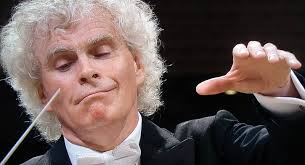On Saturday March 19, 2016, scores of fortunate movie-goers in hundreds of select theaters throughout the U.S. were treated to a one-day-only cinematic presentation by Fathom Events of ”Berlin Philharmonic: The Beethoven Project” featuring one of the world’s greatest conductors, Sir Simon Rattle, leading the incomparable Berlin Philharmonic, one of the world’s greatest orchestras.
Sir Simon has been the principal conductor of the Berlin Philharmonic since 2002 and prior to that, rose to international prominence as Music Director of the City of Birmingham Symphony Orchestra where he served for 18 years. After the expiration of his current contract in 2018 with the Berlin Philharmonic, Rattle will become Music Director of the London Symphony Orchestra. He is universally hailed as one of the greatest conductors of all time, and seeing him in action from our cinematic vantage point clearly confirmed that laudatory accolade.
The wonderful “up-close and personal” experience this filmed live performance afforded us, allowed a glimpse into Rattle’s very personal and intimate method of conducting — interacting with gesture and expressions of delight with each orchestra member — a wink here — a grin there — always reciprocated — always incredibly animated and dynamic … and always all-embracing. His love for his orchestra and what they are collectively creating informs and enhances every aspect of Beethoven’s genius.
“Berlin Philharmonic: The Beethoven Project” was divided into two parts, separated by a brief intermission.
Part I, “Living With Beethoven,” was a brilliantly informative documentary featuring on-the-spot backstage interviews with Rattle and members of the Philharmonic who explored the intricacies of Beethoven’s masterful symphonies and their approach to these masterpieces. One orchestra member for example claimed Beethoven demanded a lot of “”blowing, bowing, and banging,” whimsically reflecting on the vitality and power of the composer’s symphonies and the necessary creative effort it takes to reveal that power. Horns, fiddles and drums certainly, but most importantly, the musical genius to communicate what Beethoven was offering to all of us, and no group of musicians are better prepared to do that than the Berlin Philharmonic under the guidance of the legendary Sir Simon.
These candid interviews afforded us a wonderful introduction and understanding of the two complete symphonies that were to follow in Part II.
The first work on the program in the second half was the sunny and gracefully cheerful 4th Symphony in B-flat major. This popular piece in four movements is characterized by light instrumentation, not unlike that of Joseph Hayden with whom Beethoven had studied a decade earlier. Happily, in the documentary, Rattle’s piano demo of the adagio (“slow movement”) in the symphony’s intro to the first movement perfectly prepared us for what was to come.
Beethoven composed his 4th Symphony in the summer of 1808 and dedicated it to Count Franz von Oppersdorff who had incidentally offered him a great deal of money to compose a new symphony for him. Beethoven completed piece in one short month proving that cash is a great motivator … even among geniuses.
The second piece offered in Part II was one Beethoven claimed to be one of his best works: the 7th Symphony in A major which premiered in Vienna in 1813. He composed this work while recuperating at a spa in Teplice and dedicated it to his host, Count Moritz von Fries.
The second movement of the 7th, the allegretto (“a little lively”), is so enormously popular, it is often performed separately; it is known for it’s use of dance-like rhythms with a reliance on the string section, backed up by clarinets.
Overall it was memorable event. Too valuable to miss.
by Lidia Paulinska and Hugh McMahon
